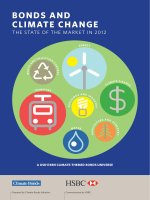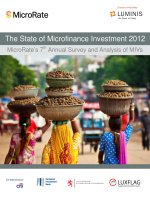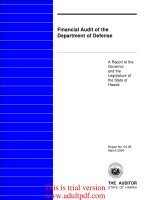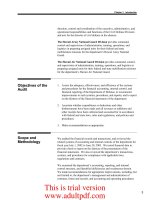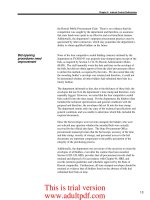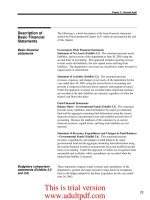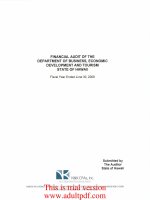skidelsky & wigstrom (eds.) - the economic crisis and the state of economics (2010)
Bạn đang xem bản rút gọn của tài liệu. Xem và tải ngay bản đầy đủ của tài liệu tại đây (951.26 KB, 140 trang )
THE ECONOMIC CRISIS AND
THE STATE OF ECONOMICS
This page intentionally left blank
THE ECONOMIC CRISIS AND
THE STATE OF ECONOMICS
Edited by Robert Skidelsky and
Christian Westerlind Wigström
THE ECONOMIC CRISIS AND THE STATE OF ECONOMICS
Copyright © Robert Skidelsky and Christian Westerlind Wigström, 2010.
All rights reserved.
First published in 2010 by
PALGRAVE MACMILLAN®
in the United States—a division of St. Martin’s Press LLC,
175 Fifth Avenue, New York, NY 10010.
Where this book is distributed in the UK, Europe and the rest of the world,
this is by Palgrave Macmillan, a division of Macmillan Publishers Limited,
registered in England, company number 785998, of Houndmills,
Basingstoke, Hampshire RG21 6XS.
Palgrave Macmillan is the global academic imprint of the above companies
and has companies and representatives throughout the world.
Palgrave® and Macmillan® are registered trademarks in the United States,
the United Kingdom, Europe and other countries.
ISBN: 978–0–230–10254–5
Library of Congress Cataloging-in-Publication Data
The economic crisis and the state of economics / edited by Robert
Skidelsky and Christian Westerlind Wigstrom.
p. cm.
Includes index.
ISBN 978–0–230–10254–5
1. Global Financial Crisis, 2008–2009. 2. Economic history—
21st century. 3. Economics. 4. Recessions. I. Skidelsky, Robert Jacob
Alexander, 1939– II. Wigstrom, Christian Westerlind.
HB37172008–2009 .E36 2010
330.9—dc22 2009040062
A catalogue record of the book is available from the British Library.
Design by Newgen Imaging Systems (P) Ltd., Chennai, India.
First edition: March 2010
10 9 8 7 6 5 4 3 2 1
Printed in the United States of America.
To economists, who may some day apply common sense.
This page intentionally left blank
CONTENTS
Preface by Robert Skidelsky ix
About the Contributors xi
About the Discussants xiii
Introduction 1
Robert Skidelsky and Christian Westerlind Wigström
Part I Risk and Uncertainty in Economics
1 Risk and Uncertainty 13
Paul Davidson
2 Lessons from Statistical Finance 31
Marc Potters
3 Ambiguity and Economic Activity: Implications for
the Current Crisis in Credit Markets 43
Sujoy Mukerji
Part II Macro-Economics and the Current Crisis
4 Macro-Economic Failures 53
Charles Goodhart
5 Hayek: Another Perspective 61
Meghnad Desai
6 Globalization and the Current Crisis 67
Christopher Bliss
viii
CONTENTS
7 Global Imbalances 83
Vijay Joshi
Part III Models, Metaphors, and Morals
8 Knowledge in Economics 91
John Kay
9 Models and Metaphors 101
Richard Bronk
10 Economics and Morals 111
Edward Skidelsky
Index 119
PREFACE
Robert Skidelsky
T
his book is the product of a symposium that I hosted on
February 13, 2009. It was partly inspired by a dissatisfaction
with the silence of the economics profession on the causes of and
the remedies for the current economic downturn. Here was an
event that was freely being compared to the Great Depression but
comments in the financial press were being provided entirely by
financial journalists. Where were the economists? Here are some
of the best of the economists and they do indeed have something
to say. A second inspiration for the symposium was that the present
crisis has brought to a head a moral dissatisfaction with the qual-
ity of capitalist civilization—obsession with growth at all costs,
neglect of traditional social values, and a lack of concern for the
environment. Many of these criticisms emerged as an attack on
globalization, but they have been given added point by the current
crisis. Today we have the attacks on “obscene” executive bonuses
and the sense of decline of social responsibility. These are moral
critiques, and I thought it would be interesting to ask questions not
just about the moral critique as it applies to the economic situation,
but also as it applies to the economics profession’s understanding of
moral issues.
I would like to thank Pavel Erochkine, Louis Mosley, Chelsea
Renton, and Christian Westerlind Wigström for their help in
organizing the conference, and the House of Lords for providing
x
PREFACE
facilities for holding it. In editing the papers for publication I
have abandoned any attempt to make them all equally intelligible
to non-economists. Much of economics is technically difficult,
requiring some knowledge of mathematics and statistics. Most of
it is more opaque than it needs to be because economists, like
other social scientists, speak to each other in a kind of short-hand
which defies outside understanding. But the courageous reader
will catch a f lavor of the argument even in the few technical essays
in this collection.
Essays by:
Christopher Bliss, Richard Bronk, Paul Davidson, Meghnad Desai,
Charles Goodhart, Vijay Joshi, John Kay, Sujoy Mukerji, Marc
Potters, and Edward Skidelsky
Contributions to the discussion from:
John Aisbitt, Gerald Holtham, Geoffrey Hosking, Will Hutton,
Paul Klemperer, Richard Layard, Peter Lilley, and Bill Robinson
ABOUT THE
CONTRIBUTORS
Christopher Bliss
Professorial Fellow and Nuffield Professor of International
Economics 1976–2007, University of Oxford. Author of Trade,
Growth and Inequality (2007).
Richard Bronk
Visiting Fellow, London School of Economics. Author of The
Romantic Economist: Imagination in Economics (2009).
Paul Davidson
Emeritus Professor of Economics, University of Tennessee. Editor
of the Journal of Post Keynesian Economics and member of the
Editorial Board of Ekonomia. He is the author, co-author, or ed-
itor of twenty-two books, the most recent one being The Keynes
Solution (2009).
Meghnad Desai
Emeritus Professor of Economics, London School of Economics,
and member of the House of Lords. Author of Marx’s Revenge: The
Resurgence of Capitalism and the Death of Statist Socialism (2002) and
Nehru’s Hero: Dilip Kumar in the Life of India (2004).
Charles Goodhart
Emeritus Professor of Banking and Finance, London School of
Economics. Former member of the MPC. Former advisor to the
Governor of the Bank of England.
xii
ABOUT THE CONTRIBUTORS
Vijay Joshi
Fellow of St John’s College, and Emeritus Fellow of Merton
College, Oxford. Co-author of India: Macroeconomics and Political
Economy (1994). Former Economic Advisor to the Government of
India and the World Bank.
John Kay
Visiting Professor, London School of Economics, and weekly col-
umnist in the Financial Times. Author of The Long and the Short of
It (2009).
Sujoy Mukerji
Professor of Economics, University of Oxford, and the author of
articles on uncertainty and ambiguity.
Marc Potters
Head of Research at Capital Fund Management, and co-author of
Theory of Financial Risk and Derivative Pricing (2003).
Edward Skidelsky
Lecturer in Philosophy, University of Exeter, and author of Ernst
Cassirer: The Last Philosopher of Culture (2009).
Robert Skidelsky
Emeritus Professor of Political Economy, University of Warwick,
and member of the House of Lords. Author of a three-volume
biography of John Maynard Keynes and Keynes: The Return of the
Master (2009).
Christian Westerlind Wigström
PhD student in International Relations at the University of
Oxford.
ABOUT THE DISCUSSANTS
John Aisbitt
Chairman of the Man Group plc and former partner at Goldman
Sachs.
Gerald Holtham
Managing Partner of Cadwyn Capital LLP and Visiting Professor
at Cardiff Business School. He was formerly Chief International
Economist at Lehman Brothers, Europe, and Head of the General
Economics Division at the OECD in Paris.
Geoffrey Hosking
Emeritus Professor Russian History, University College
London.
Will Hutton
Executive Vice-Chair of The Work Foundation, weekly colum-
nist, and the author of The Writing On The Wall: China and the West
in the 21st Century (2007). He is a former editor-in-chief of The
Observer.
Paul Klemperer
Edgeworth Professor of Economics, University of Oxford, and
author of Auctions: Theory and Practice (2004).
Richard Layard
Programme Director at the Centre for Economic Performance,
London School of Economics, and member of the House of Lords.
He is the author of Happiness: Lessons from a New Science (2005).
xiv
ABOUT THE DISCUSSANTS
Peter Lilley
MP since 1983, former Secretary of State for Trade and Industry
1990–1992, Secretary of State for Social Security 1992–1997 and
Shadow Chancellor of the Exchequer 1997–1998.
Bill Robinson
Chief Economist at KPMG, former Head UK Business Economist
at PricewaterhouseCoopers.
THE ECONOMIC CRISIS AND
THE STATE OF ECONOMICS
This page intentionally left blank
INTRODUCTION
Robert Skidelsky and Christian Westerlind Wigström
K
eynes wrote of his General Theory of Employment, Interest, and
Money (1936) that it was “an attempt to bring to an issue
deep divergences of opinion between fellow economists which has
for the time being destroyed the practical influence of economic
theory.” That seems not unlike the situation at the moment. A
heated discussion between rival schools has been going on in the
blogosphere; of this, hardly an echo appears even in the financial
press. The foremost battle concerns the effects of the “stimulus.”
This is waged between the “freshwater economists” of Chicago
University and the “saltwater economists” of the east and west
coasts. Eugene Fama, who is a Professor of Finance at Chicago
University, and the godfather of the Efficient Market Theory,
encapsulated the Chicago view when he said that all a stimulus
did was to shift resources from the private to the public sector of
the economy, so that its stimulating effect was, in effect, zero, or
even less. An enraged Paul Krugman responded that this was to
take economics back to the dark ages. The historically minded
will recall that this is a re-run of the debates about policies for the
Great Depression. Keynes wrote his General Theory to refute the
“Treasury View” of the 1920s that the only effect of public spend-
ing was to “crowd out” private spending.
Keynes argued this was true only if the economy was fully
employed. If there were unemployed resources, extra public
2
SKIDELSKY AND WESTERLIND WIGSTRÖM
spending could take the place of the absent private spending, and
thus raise aggregate demand to a full employment level. Underlying
this debate is a basic disagreement between economists about how
the economy works. If you believe that it is always fully employed,
or that recessions are in some sense “optimal,” then it follows that
a “stimulus” will do no good. If you believe, with Keynes, that
collapses of aggregate spending are possible, then a “stimulus” can
improve the situation. The fact that this kind of debate is inter-
minable only shows how far economics is from being the natural
science many of its practitioners claim it to be.
Papers and Discussion
Three main themes emerged from the papers and the discussions
that followed: the question of whether future events are a matter of
uncertainty rather than risk; the impact of global macroeconomic
imbalances; and the role of economic models. Paul Davidson strongly
advocates a view of the future as irreducibly uncertain. Unlike in the
“hard sciences” such as physics or astronomy, in economics, there
is no foundation on which to base any probabilities about future
events. While astronomers can be reasonably confident that a planet
will appear in a predicted place at a predicted time the same cannot
be said about many subjects of interest to economists. Probabilities
calculated on past and current market data cannot be taken to hold
about future events since, as Davidson argues, there is no way of
knowing what social and economic events will occur in the future.
Thus, the future is not “ergodic”—it is not predetermined. Yet, the
ergodic axiom is at the heart of key theories such as the efficient-
market hypothesis which states that markets price assets correctly
based on all available past and present information. Without the pos-
sibility of assigning actuarial probabilities to future events, the value
of assets cannot be efficiently established. In effect, the efficient-
market hypothesis assumes that all uncertainty can be reduced to
calculable risk. The failure to recognize this fallacy has led to the
bankruptcy of major financial institutions such as AIG as well as a
3
INTRODUCTION
false sense of security which paved the way for panic once the foun-
dations trembled. Davidson argues for the introduction of a “market
maker”—an institution that assumes responsibility for keeping the
market liquid in the face of unforeseeable events—in order to lessen
the effects of uncertainty. Sujoy Mukerji lends support to Davidson’s
emphasis on irreducible uncertainty as an explanation for the crisis.
In situations of uncertainty it is often the case that the decision mak-
er’s knowledge about the likelihood of contingent events is consistent
with more than one probability. Under such conditions it is rational
not to act. In financial markets this leads to a situation in which
more ambiguity results in less trade and lending. “The uncertainty is
triggered by unusual events and untested financial innovations that
lead agents to question their worldview.” In other words, rather than
subjecting investments to incalculable risks no investments are made
at all. Instead, people hoard cash—an idea conforming to Keynes’s
liquidity preference theory. Thus, the present crisis can be under-
stood as having erupted because of increasing uncertainty amidst
rapid financial innovation—an idea closely related to the discussion
in Richard Bronk’s chapter. At some point investors and banks with-
drew their capital and credit, leaving consumers and companies and
ultimately themselves without adequate financing. This suggests that
a policy promoting transparency and other uncertainty-reducing
objectives could mitigate the financial downturn and ease credit
markets. We are in need of qualitative rather than quantitative eas-
ing. Marc Potters, on the other hand, does not dismiss the ability
of economic modeling to assign accurately probabilities to future
events. The future is not exclusively characterized by irreducible
uncertainty. During the discussion this position was seconded by
Paul Klemperer. Christopher Bliss who supported this stand went
on to say that if the past and present say nothing about the future,
as Davidson’s rejection of the ergodic axiom implies, “We might as
well all go home.” Potters argues that, rather than facing a principal
problem with uncertainty, influential pricing models have typically
relied on assumptions too simple to have any relation to the reality
4
SKIDELSKY AND WESTERLIND WIGSTRÖM
they seek to predict. For instance, the Gaussian processes assumed in
the Black and Scholes option pricing model imply a disregard for the
relative frequency of extreme fluctuations observed in the empirical
data. In contrast to the assumptions of this model, volatility is not
constant. The invalidity of these assumptions implies that there
can be no zero-risk options as the model predicts. In other words,
“option trading involves some irreducible risk.” Moreover, conven-
tional wisdom in mathematical finance treats prices as “god-given,”
yet feedback loops indicate that this is fundamentally wrong. Large
purchases of assets increase their price thereby prompting further
purchases, or—conversely—decreasing prices result in investors sell-
ing thereby further lowering the price. In effect, the financial crisis
can be explained by means of such a positive feedback loop. Under
such circumstances the degree of correlation among instruments
changes—a consideration only very rarely included in financial
mathematical models. Mathematical tractability and methodolog-
ical consistency have made these models attractive, despite their
flaws. However, if the models were better understood and improved
there is scope for modeling to reduce the degree of uncertainty in
the economy. The problem is that a lot of people can make huge
amounts of money by not understanding the models they are using.
This ties in with Christopher Bliss’s emphasis on asymmetric infor-
mation: bankers provide credit to investment projects they have only
very limited information about. Rating agencies and diversification
of asset portfolios are intended to reduce the risk associated with
asymmetric information, yet the rating agencies have incentives to
award higher ratings than deserved and, as Potters points out, diver-
sified portfolios do not reduce risk as soon price movements are cor-
related. Thus, according to Bliss, “markets function poorly, if they
function at all, in situations characterized by asymmetric informa-
tion.” And this problem is exacerbated when the distinction between
investment and retail banks is blurred. “Safe” deposits end up being
used for speculation. Once the bubble bursts the crisis migrates
quickly from finance to the real economy. However, asymmetric
5
INTRODUCTION
information only explains the speculative side of the crisis—it does
not explain how consumers in the West could enjoy low inflation,
cheap money and high profits at the same time—all of which fuelled
an unprecedented growth in credit.
Bliss argues that competition from East Asia, predominantly
China, was responsible for this. A Chinese “saving glut” in the
form of enormous investments in American Treasury Bills kept the
Chinese currency artificially low and made Chinese companies
super competitive. Cheap imports kept prices low while cheap
Chinese labor stifled the increase in Western real wages. In effect,
the resulting imbalances led to a situation in which East Asia
financed Western current account deficits. Vijay Joshi explains the
origins of the Asian saving glut by referring to two projects: the
creation of foreign currency reserves as a precautionary buffer—
the value of which the East Asian countries understood after the
1997 f inancial crisis; and the policy decision of these states to pursue
export-led growth as a means to economic development. Both
projects were facilitated by keeping their own currencies low rela-
tive to the reserve currency—the dollar. This was achieved by
investing heavily in the American credit markets. The ensuing
macroeconomic imbalances were not sustainable in the long run.
Joshi argues that had American house prices not fallen, an adjust-
ment process would have started with a fall of the dollar. The ques-
tion of why central banks don’t prick bubbles before they become
unmanageable was raised in the discussion with Peter Lilley point-
ing to the political consequences of halting growth at a time when
it is diff icult to establish whether the economy truly is experiencing
a bubble or not. Joshi argued that in order to forestall similar bub-
bles appearing in the future central banks on a national level, must
look beyond consumer price indices as key indicators of the health
of the economy. They need to look at asset and credit price move-
ments too. Bill Robinson agreed with the view that central banks
require further tools along side the interest rate: for example, a
mandate to regulate banks’ capital charges. Joshi called for a
6
SKIDELSKY AND WESTERLIND WIGSTRÖM
strengthening of key financial institutions such as the IMF to pre-
vent the creation of unsustainable imbalances on an international
level. The world needs a “neutral” reserve currency and agree-
ments on exchange rate regimes. Although macroeconomic theory
cannot be blamed for global imbalances, it shows weakness in its
inability to foresee these consequences. In part this weakness stems
from reliance on inappropriate models—a theme strongly repre-
sented both in the papers and discussions. To John Kay “the test of
an economic model is whether it is useful rather than whether it is
true.” We should not be concerned about whether the efficient-
market theory is true or not. It is neither. Markets are often effi-
cient but economists take this to mean that they are always efficient.
Information is included in prices but it is not necessarily correctly
weighted. The same goes for views on risk. The theory of subjec-
tive expected utility is neither true nor false. It is illuminating.
Economic theories are metaphors and models and not realistic
descriptions. We need to be able to choose when to use which met-
aphor. “The skill of the economist is in deciding which of many
incommensurable models one should apply in a particular context.”
Keynesian uncertainty which considers confidence, narratives and
degrees of belief in those narratives has all but become extinct yet
Keynes’s perception of risk is no less important than the dominant
classical risk paradigm. Economists need to be eclectic. Otherwise
we end up in the situation described by Charles Goodhart.
Goodhart describes how Dynamic Stochastic General Equilibrium
(DSGE) models work well in good times when default rates on
loans are low but badly in bad times. In part he attributes this
weakness to the transversality condition which stipulates that an
economic agent has used all his resources and paid all his debts by
the time he dies. This, Goodhart observes, hardly corresponds to
reality. Amongst economists a flawed but rigorous theory often
beats a correct but literary exposition. This has led to an overcon-
fidence in markets based on rigorous but incorrect theories such as
the efficient market theory. However, there is a large difference
7
INTRODUCTION
between what academic economists think and what businessmen
do. Given that economists and financial practitioners accept that
prices can move away from fundamentals it is absurd to believe in
the efficient market theory. Consequently, “our standard macro
models [. . .], which virtually everybody has been using, tell us
absolutely nothing about our present problems.” This mismatch
between how economists and the business world interpret data is
the starting point for Richard Bronk’s paper. Despite rapid innova-
tion having introduced dynamism and uncertainty, economists rely
on equilibrium models and risk. This is, Bronk argues, a result of
the choice of metaphors employed within economics and thereby
links up with Kay’s view of economic models as illuminations
rather than descriptions of reality. In the discussion, Paul Klemperer
agreed with this: models are metaphors, often with multiple inter-
pretations. Different settings, Klemperer argued, requires different
models often based on an understanding of sociology and psychol-
ogy. According to Bronk the Romantics looked at the nature of
creativity and concluded that the world as we see it is, to some
extent, a creation of our minds. The way we use models structures
the way we analyze and interpret what we observe. “If the model
seems to be useful, you may soon forget how necessarily stylized
this picture is.” Your perspective affects your view. Newtonian
analogies suggest equilibria where romanticism would have pointed
to dynamism. No one model says everything. Contemporary mod-
els’ tendency to treat uncertainty as risk has had huge consequences
for the world economy and contributed to the crisis, as Davidson
and Mukerji noted. Bronk notes that “there was, in retrospect,
something absurd in relying so completely on risk models based on
correlations trawled from data on the past at the very moment when
bankers were creating new complex products each and every
week.” Again, this points not only to the necessity of greater care
when choosing models but also to the need for a greater awareness
of the biases that come with it. Meghnad Desai’s chapter illustrates
the point. The streamlining of economic theory has limited the
8
SKIDELSKY AND WESTERLIND WIGSTRÖM
realm of possible approaches to analyzing and mitigating the cur-
rent crisis by excluding certain perspectives. He argues that we
should look at the ideas developed by Hayek to get a better idea of
the unfolding of recent events. Hayek combined Walras with
money to explain business cycles. Credit creation by the banking
system produces overinvestment in relation to voluntary saving.
The overinvestment can be kept going only by injecting more and
more inflation into the system. In raising the rate of interest to
liquidate inflation banks curtail the credit needed to complete the
investment projects so investment collapses, and the economy con-
tracts. Hayek believed that once the credit creation had occurred
there was no way of mitigating the subsequent collapse. The
important thing was to prevent the excessive credit creation in the
first place. Hayek has long disappeared from economic textbooks
yet, as Desai remarks, “if you cast your memory back, economics
was never uniform.” A heterogeneous discipline is needed once
again. Edward Skidelsky argues that the moral underpinnings of
the discipline have to be enriched as well. Whereas classical eco-
nomics was concerned with agents acting in pure self-interest,
today’s economics is—though based on choices between compet-
ing preferences—silent as to the content of those preferences. The
absence of preference content can be seen as a sign of tolerance.
However, Skidelsky argues that egoism remains implicit in the
method of economics. Economists do not tackle the non-economic
side of life yet aspire to explain everything. Although not all goods
are commensurable, economists treat them as subject to equal
trades. A moral person does not weigh the costs and benefits of
stealing a wallet. He does what he knows is right. The moral prin-
ciple cannot be traded against the bank balance. Simplification
deprives economics of the power to tackle many of the problems it
seeks to solve. Reflecting Bliss’s remark that “insecurity and
inequality are what matter most” in terms of making people
unhappy—not absolute income and growth—Skidelsky highlights
the importance of non-economic considerations which economics
